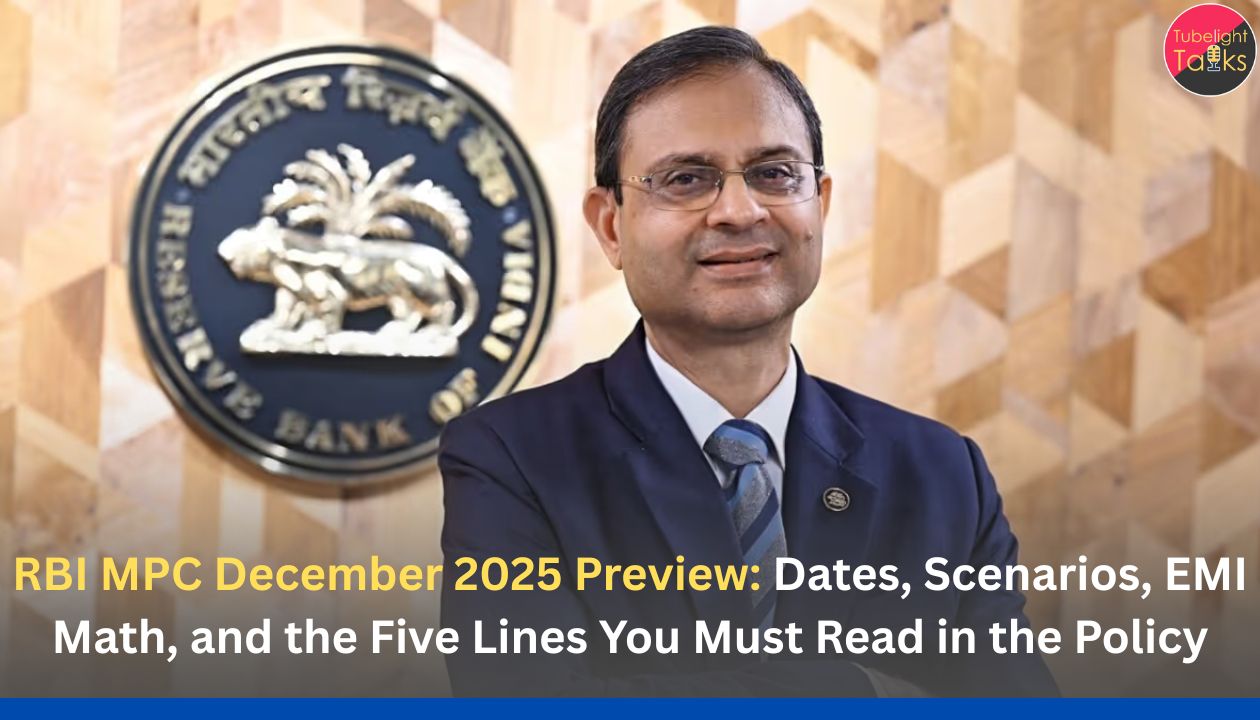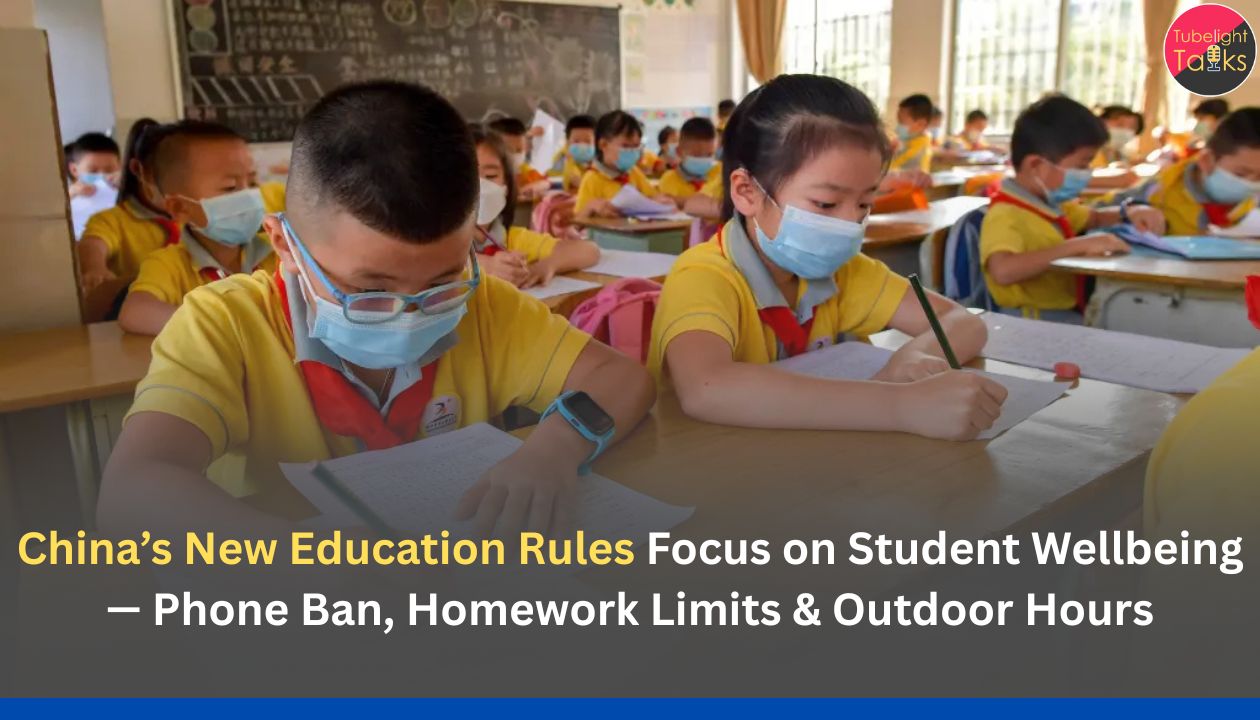RBI MPC December 2025: India’s Monetary Policy Committee (MPC) goes into its final meeting of 2025 with inflation dramatically softer and growth guidance surprisingly firm. In October, the RBI kept the repo rate at 5.50% with a neutral stance but cut FY26 inflation to 2.6% and raised growth to 6.8%. Since then, a Reuters poll suggested October CPI may have fallen to a multi-year low; the official CPI print is scheduled for Wednesday, November 12, 2025.
With the next MPC widely expected in early December (Dec 3–5, media), here’s a sourced field guide to the dates, scenarios, and the lines that will matter for EMIs, markets, and budgets.
The calendar and why each date matters
- CPI (October 2025) — Nov 12, 2025: MoSPI’s last CPI press note lists Nov 12 as the next release for October CPI. This number is the final, in-period inflation read the MPC will see before the December vote; it will shape both the headline and food narrative in the resolution.
- MPC meeting window — early December: Media reporting (post-October minutes) places the next MPC on Dec 3–5. RBI will publish the Resolution and the Governor’s statement, followed by the press conference. Use RBI’s communication page and the PIB summary as your primary anchors on policy day.
What RBI already said in October (and why it’s a big deal)
- Repo: 5.50%, neutral stance.
- FY26 GDP: upgraded to 6.8%.
- FY26 CPI: downgraded to 2.6% (from 3.1%).
These are official numbers from the RBI policy communication carried by PIB; they underpin the “room to ease” conversation. Minutes released later reinforced that the inflation outlook had softened, with a couple of members arguing for stronger pro-growth signaling while others urged caution until more data accumulate.
The CPI backdrop going into December
- September CPI: fell to ~1.5% y/y (press accounts quoting MoSPI), the lowest since 2017, mainly on persistent food disinflation.
- October CPI (poll): median expectation around 0.5%, again reflective of food softness and base effects. Final print arrives Nov 12.
- WPI: September WPI also pointed to disinflation (food index negative), consistent with a softer deflator path.
“RBI kept repo at 5.50%, raised FY26 growth to 6.8%, and lowered inflation to 2.6% in October;”
The policy you must read and why
- Inflation outlook paragraph — Watch the food sub-lines (vegetables, pulses, oils) and references to base effects and PDS treatment in the CPI revision process. MoSPI’s CPI methodology work and discussion papers will increasingly shape how markets read the path.
- Growth outlook paragraph — RBI’s 6.8% FY26 baseline: does it cite investment/improving government capex and external drags? The stickiness here determines how aggressive easing can be.
- Liquidity & stance — Any nuance on durable liquidity (VRR/VRRR), GSAP-style operations, or explicit easing bias clues.
- Transmission — Lines on bank MCLR/RLLR pass-through; what RBI says about spreads and lending standards matters for SMEs.
- Risk box — A new paragraph on tariffs/geopolitics/weather can temper rate-cut hopes even if the CPI is soft.
Borrowers’ corner: quick EMI math
- A 25 bps repo cut typically nudges floating-rate home loan EMIs lower by ~₹16–17 per lakh on a fresh 20-year loan (approximation; bank spreads and resets apply).
- Reset cadence matters: RLLR-linked loans usually move faster than MCLR-linked ones; check your reset date.
- Prepayment strategy: If rates fall, consider small, regular prepayments to knock off tenure—often superior to waiting for EMI reductions.
Corporate CFO playbook (Dec–Mar)
If Scenario A (cut) lands
- Pre-refi windows open—consider commercial paper and short tenors; lock ratings paperwork now.
- Hedge policy: lighten long-dated payers; review FX overlays if your export book benefits from lower carry.
If Scenario B (hold + easing bias)
- Run “soft-landing” budgets: reduce interest-cost assumptions for Q4; build in 5–10 bps better pricing for top-tier issuances.
- Keep optionality: maintain undrawn bank lines; watch RBI commentary on liquidity.
If Scenario C (hold + neutral)
- Treat it as a “verify again in January/February” message; avoid aggressive duration bets; prioritize operational cash buffers.
For households: what to do before policy day
- Don’t refinance in a rush. Wait for the policy resolution and a couple of bank resets.
- Fix vs float: If you’re risk-averse and the bank offers a modest premium for fixed, a partial fix (e.g., 50% of principal) can balance risk.
- SIP discipline: In a soft-inflation, steady-growth regime, avoid timing the market; let asset allocation do the work.
The inflation data, carefully sourced
- MoSPI: The official CPI press notes and release calendar (September release; October scheduled Nov 12). Bookmark the press-release page and CPI hub for PDFs and annexures.
- WPI: Department for Promotion of Industry & Internal Trade (DPIIT) monthly report—food index showed negative inflation in September. Use WPI only as context; CPI drives the MPC mandate.
- Polls: Reuters’ Oct CPI poll value (~0.5%) is context until MoSPI publishes.
Markets lens: bonds, equities, INR
- Bonds: The combination of FY26 CPI 2.6% and soft prints should anchor real rates comfortably positive; if the RBI signals a cut, expect the 2–5Y sector to lead.
- Equities: Lower discount rates favour domestic demand pockets (autos, durables, housing ancillaries).
- INR: A modest policy easing won’t necessarily weaken INR if disinflation is credible and balances of payments stay steady; watch global risk.
Sound Money, Sound Conduct
Low inflation and careful rate decisions affect every kitchen budget and every EMI, but policy alone cannot produce lasting well-being. As per Sant Rampal Ji Maharaj teachings, that comes from everyday conduct—truthful work, non-exploitation, paying people on time, and resisting shortcuts. In households, it looks like living within means and helping a neighbour in distress; in companies, it means transparent pricing and fair contracts.
When we practise these simple virtues, prosperity becomes more stable: less anxiety when rates move, fewer crises when the cycle turns. Readers who want a values-first lens on daily decisions—in home finance or at work—can explore practical teachings emphasising honest work and responsibility (see the accessible book Way of Living (Jeene Ki Raah) and related discourses).
Be Policy-Ready—Not Headline-Driven
Build your pre-policy checklist now
- Bookmark sources: RBI policy page/PIB summary for the official stance & tables; MoSPI for CPI PDFs.
- Write two headlines: one for a hold, one for a 25 bps cut—swap numbers post-release.
- Model the EMI math: keep a small calculator tile for ₹/lakh impact and reset dates.
- For CFOs: pre-draft a debt action note (duration, CP window, hedges) for each scenario; align with Board sign-offs.
- For citizens: set calendar reminders for bank reset dates; compare rates before refinancing.
FAQs: RBI MPC December 2025
Q1. When is the December 2025 MPC meeting?
Media reporting alongside October minutes points to Dec 3–5, 2025. RBI will publish the Resolution and hold its press conference on policy day. Use official RBI/PIB pages for confirmation.
Q2. What did RBI project in October?
Repo 5.50%, stance neutral; FY26 GDP 6.8% and FY26 CPI 2.6%—these are official.
Q3. When is the October CPI released?
November 12, 2025 (Wednesday), per MoSPI’s September press note.
Q4. How low is inflation right now?
September CPI fell to about 1.5% (8-year low, per press coverage of MoSPI data); a Reuters poll tipped October CPI near 0.5%—await MoSPI’s official print.
Q5. Does a 25 bps cut slash my EMI immediately?
Not instantly. It feeds through at your loan’s reset date (MCLR/RLLR rules), and banks’ spreads also matter.
Q6. Where can I watch the Governor’s statement?
RBI streams the decision and the Governor’s remarks on its website and social channels per its communication policy.










